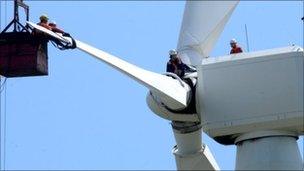Goonhilly wind turbines output estimate cut
- Published

New turbines are due to be put in place in September
A new wind farm at Goonhilly in Cornwall will produce less power than was predicted at the planning stage.
Cornwall Light and Power (CLP) said in 2007 that six new 2.5 megawatt turbines would give power for 7,360 households.
The turbines, due be put in place in September, will now be 2 megawatt machines, possibly enough for about 5,500 homes according to one expert.
CLP said it would consider changing the expected output figures on its website.
CLP is replacing 14 of its 25m (82ft) high wind turbines at the site on the Lizard with six machines that are 107m (350ft) high.
It refers on its website, Goonhilly Green Power, to its 2007 planning application that was based on six 2.5 megawatt turbines.
The document states that overall output would be enough for 7,360 households.
CLP is now installing 2 megawatt machines, which are due to be put in place in September, because of "commercial availability".
But Michael Jefferson, Professor of International Business and Sustainability at the London Metropolitan Business School, told BBC News the CLP figures were "totally unrealistic".
Goonhilly's 14 turbines produced just 15.9% of their output capacity of 5.6 megawatts in 2009, according to figures from electricity regulator Ofgem.
He said even if the turbines were operating at 30% capacity, only 5,456 households would be served.
"To get to 7,360 households you need to assume a capacity factor each year averaging over 40%," he said.
"The highest in England last year was 32%.
"However, the average for the nine developments operational in Cornwall last year was 22.37%."
Tristan Mackie, CLP project liaison officer, blamed the 15.9% output capacity on ageing machines, which were not always operating in 2009.
He said CLP's figures were "relevant at the planning application stage".
He added that the website would be updated with new figures.
"The thing with websites is they need updating all the time.
"It doesn't make it right or wrong."
"We will look at the numbers and make sure we state them as accurately as we possibly can."
- Published22 July 2010